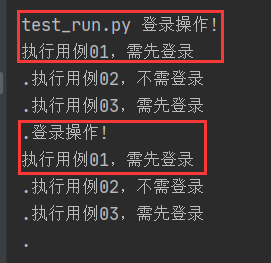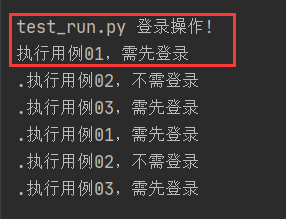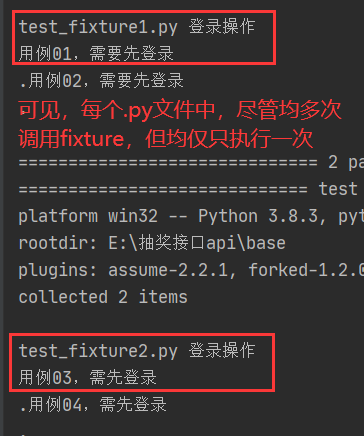pytest测试框架 -- assert断言和fixture固件
一、断言
(1)使用assert语句进行断言
# test_run.py def test_assert(self): r = requests.get("https://www.baidu.com") assert r.status_code == 100
# pytest常用的python断言: 1)assert xx:判断xx为真 2)assert not xx:判断xx不为真 3)assert a in b:判断b包含a 4)assert a not in b: 判断b不包含a 5)assert a == b:判断a等于b 6)assert a !=b:判断a不等于b
(2)使用pytest.raises触发期望异常的断言
# test_run.py def test_assert(self): r = requests.get("https://www.baidu.com") with pytest.raises(AssertionError) as excinfo: assert r.status_code == 201 # 此处可能存在异常,所以主动raises抛出 print("This will be not execute") # 此处未被执行 assert excinfo.type == AssertionError # 此处被执行 assert "200" in str(excinfo.value) # 此处被执行 print("This will be execute") # 此处被执行
excinfo 是一个异常信息实例,它是围绕实际引发的异常的包装器。主要属性是.type、 .value 和 .traceback
注意:断言type的时候,异常类型是不需要加引号的,断言value值的时候需转str。
二、fixture的使用
(1)fixture的作用
- 完成setup和teardown操作,处理数据库、文件等资源的打开和关闭
- 完成大部分测试用例需要完成的通用操作,例如login、设置config参数、环境变量等
- 准备测试数据,将数据提前写入到数据库,或者通过params返回给test用例,等
- 命名方式灵活,不局限于setup和teardown这几个命名
- conftest.py 配置里可以实现数据共享,不需要import就能自动找到一些配置
- scope="function",若多个用例都调用了fixture函数,则此fixture在每个用例开始前都执行一次
- scope="class",如果一个class的多个用例都调用了次fixture,则此fixture仅在第一次调用开始前执行一次,后续调用不执行
- scope="module" 在当前.py脚本里面所有用例开始前只执行一次。
- scope="session" 以实现多个.py跨文件使用一个session来完成多个用例
fixture(scope='function',params=None,autouse=False,ids=None,name=None):
scope:有四个级别参数"function"(默认),"class","module","session"
params:一个可选的参数列表,它将导致多个参数调用fixture功能和所有测试使用它。
autouse:如果True,则为所有测试激活fixture func可以看到它。如果为False则显示需要参考来激活fixture
ids:每个字符串id的列表,每个字符串对应于params这样他们就是测试ID的一部分。如果没有提供ID它们将从params自动生成
name:fixture的名称。这默认为装饰函数的名称。如果fixture在定义它的统一模块中使用,夹具的功能名称将被请求夹具的功能arg遮蔽,解决这个问题的一种方法时将装饰函数命令"fixture_<fixturename>"然后使用"@pytest.fixture(name='<fixturename>')"。
(4)源码演示1、若scope="function"
@pytest.fixture() def login(): print("登录操作!") def test_01(login): print("执行用例01,需先登录") def test_02(): print("执行用例02,不需登录") def test_03(login): print("执行用例03,需先登录"
输出结果:

2、若scope="class"
@pytest.fixture(scope='class')
def login():
print("登录操作!")
class TestFixture1():
def test_01(self, login):
print("执行用例01,需先登录")
def test_02(self):
print("执行用例02,不需登录")
def test_03(self, login):
print("执行用例03,需先登录")
class TestFixture2():
def test_01(self, login):
print("执行用例01,需先登录")
def test_02(self):
print("执行用例02,不需登录")
def test_03(self, login):
print("执行用例03,需先登录")
输出结果:

@pytest.fixture(scope='module') def login(): print("登录操作!") class TestFixture1(): def test_01(self, login): print("执行用例01,需先登录") def test_02(self): print("执行用例02,不需登录") def test_03(self, login): print("执行用例03,需先登录") class TestFixture2(): def test_01(self, login): print("执行用例01,需先登录") def test_02(self): print("执行用例02,不需登录") def test_03(self, login): print("执行用例03,需先登录")
输出结果:

4、若scope="session"
fixture为session级别是可以跨.py模块调用的,也就是当我们有多个.py文件的用例的时候,如果多个用例只需调用一次fixture,那就可以设置为scope="session",并且写到conftest.py文件里。
conftest.py文件名称时固定的,pytest会自动识别该文件。放到项目的根目录下就可以全局调用了,如果放到某个package下,那就在该package内有效。
一个工程下可以建多个conftest.py的文件,一般在工程根目录下设置的conftest文件起到全局作用。在不同子目录下也可以放conftest.py的文件,作用范围只能在该层级以及以下目录生效。
# conftest.py import pytest @pytest.fixture(scope='session') def test1(): print("登录操作")
# test_fixture1.py import pytest def test_01(test1): print("用例01,需要先登录") def test_02(test1): print("用例02,需要先登录") if __name__ == "__main__": pytest.main(['-s', 'test_fixture1.py']) pytest.main(['-s', 'test_fixture2.py'])
# test_fixture2.py import pytest class TestCase(): def test_03(self, test1): print("用例03,需先登录") def test_04(self, test1): print("用例04,需先登录") if __name__ == "__main__": pytest.main(['-s', 'test_fixture2.py'])
(1)若pycharm下运行test_fixture1.py,则输出结果如下:

(2)若在命令行下同时运行test_fixture1.py 和test_fixture2.py两个文件,则结果输出如下:

三、使用装饰器@pytest.mark.usefixtures()修饰需要运行的用例
如果一个方法或者一个class用例想要同时调用多个fixture,可以使用@pytest.mark.usefixture()进行叠加。注意叠加顺序,先执行的放底层,后执行的放上层。
import pytest
@pytest.fixture()
def test1():
print("执行function1")
@pytest.fixture()
def test2():
print("执行function2")
@pytest.mark.usefixtures('test1')
def test_01():
print("---用例a执行---")
@pytest.mark.usefixtures('test1') # 后执行
@pytest.mark.usefixtures('test2') # 先执行
class TestCase():
def test_02(self):
print("---用例b执行---")
def test_03(self):
print("---用例c执行---")
输出结果:
test_fixture2.py 执行function1
---用例a执行---
.执行function2
执行function1
---用例b执行---
.执行function2
执行function1
---用例c执行---
usefixtures与传fixture区别
(1)如果fixture有返回值,那么usefixture就无法获取到返回值,这个是装饰器usefixture与用例直接传fixture参数的区别。
(2)当fixture需要用到return出来的参数时,只能将参数名称直接当参数传入,不需要用到return出来的参数时,两种方式都可以。
四、使用pytestmark或autouse使得每个函数都调用该固件
(1)如果你想要模块中的每个函数都调用该固件,你也可以使用pytestmark标记(注意:pytestmark变量名不可更改)
import pytest @pytest.fixture() def test2(): print("执行function2") pytestmark = pytest.mark.usefixtures('test2') def test_01(): print("---用例a执行---") class TestCase(): def test_02(self): print("---用例b执行---") def test_03(self): print("---用例c执行---")
输出结果:
test_fixture2.py 执行function2
---用例a执行---
.执行function2
---用例b执行---
.执行function2
---用例c执行---
(2)使用@pytest.fixture()中的参数autouse(自动使用),将其设为true(默认为false),这样每个函数都会自动调用该前置函数了:
import pytest @pytest.fixture(autouse='true') def test1(): print("执行function1") def test_01(): print("---用例a执行---") class TestCase(): def test_02(self): print("---用例b执行---") def test_03(self): print("---用例c执行---")
输出结果:
test_fixture2.py 执行function1
---用例a执行---
.执行function1
---用例b执行---
.执行function1
---用例c执行---
五、params参数化
params参数可以实现前置函数的参数化,调用前置函数的测试用例可以根据前置函数不同的参数执行多次。
在fixture标签中的params参数传入了列表类型的参数列表;我们又在前置函数中传入了request参数;最后在测试函数中我们通过request.param来表示参数(参数列表中的每个值)
import pytest @pytest.fixture(params=['参数1','参数2']) def test1(request): print("执行前置函数, %s" % request.param) def test_01(test1): # 注意,此时test1未用引号 print("---用例a执行---") class TestCase(): def test_02(self): print("---用例b执行---") def test_03(self): print("---用例c执行---")
输出结果:
test_fixture2.py 执行前置函数, 参数1
---用例a执行---
.执行前置函数, 参数2
---用例a执行---
.---用例b执行---
.---用例c执行--
或者:
import pytest
import requests
url_datas = ["http://www.baidu.com", "http://www.weibo.com"]
@pytest.fixture(params=url_datas)
def get_url(request):
return request.param
def test_get_status_code(get_url):
r = requests.get(get_url)
print(r.status_code)
if __name__ == "__main__":
pytest.main(['-s', 'test_fixture1.py'])
输出结果:
test_fixture1.py 200
.200
.
使用yield实现前置和后置函数(如setUp和tearDown)。
yield相当于 return 返回一个值,并且记住这个返回的位置,下次迭代时,代码从yield的下一条语句开始执行。
import pytest def connect(): print("连接数据库") def disconnect(): print("断开数据库") @pytest.fixture(scope="class") def databases(): connect() # 前置函数 yield disconnect() # 后置函数 def test_01(databases): print("执行用例a") class TestCase(): def test_02(self, databases): print("执行用例b") def test_03(self, databases): print("执行用例c") if __name__ == "__main__": pytest.main(['-s', 'test_fixture1.py'])
运行结果:
连接数据库
执行用例a
.断开数据库
连接数据库
执行用例b
.执行用例c
.断开数据库
@pytest.mark.parametrize参数化:参数为列表数据
# get_excel.py # 读取excel表的数据 from openpyxl import load_workbook
class ExcelData(): def __init__(self, file, sheet_name): '''初始化Excel对象''' self.file = file self.wb = load_workbook(self.file) self.sh = self.wb[sheet_name] def get_row_value(self, row): '''获取Excel中某一行数据''' max_col = self.sh.max_column row_value = [] for col in range(1, max_col+1): value = self.sh.cell(row, col).value row_value.append(value) return row_value def get_all_row_value(self): '''获取Excel中所有行的数据''' max_row = self.sh.max_row row_value = [] for row in range(2, max_row+1): value = self.get_row_value(row) row_value.append(value) return row_value
# test_student.py from bases.get_excel import ExcelData import pytest import requests import json # 登录接口的数据 file_path = r'E:\ApiAuto\testdata\datas1.xlsx' login_excel = ExcelData(file_path, 'login') login_data = login_excel.get_all_row_value() class TestStudent(): '''学生模块api''' def assertHandler(self, excel, response, expect_result, row_index, response_index, conclusion_index): '''将实际结果写入Excel文件中''' excel.write_value(row_index, response_index, response) response = json.loads(response) try: '''断言,比较实际结果与预期结果''' assert response['error_code'] == expect_result except Exception as e: '''将测试结论写入Excel文件中''' login_excel.write_value(row_index, conclusion_index, "fail") print("测试失败!") raise e else: login_excel.write_value(row_index, conclusion_index, "pass") print("测试通过") @pytest.mark.parametrize('student', login_data) def test_login(self, student): '''登录接口''' is_execute = student[2] url = student[4] method = student[5] username = student[6] passwd = student[7] response_index = 10 expect_result = student[10] conclusion_index = 12 row_index = student[12] + 1 if is_execute == "yes": body = { 'username': username, 'passwd': passwd, } print("用例ID:", student[0]) print("模块:", student[1]) print("用例标题:", student[3]) response = requests.request(url=url, method=method, data=body).text '''断言处理''' self.assertHandler(login_excel, response, expect_result, row_index, response_index, conclusion_index) if __name__ == "__main__": pytest.main(['-s', __file__])
参考:https://www.cnblogs.com/huizaia/p/10331469.html
参考:https://blog.csdn.net/qq_39721240/article/details/88650329



